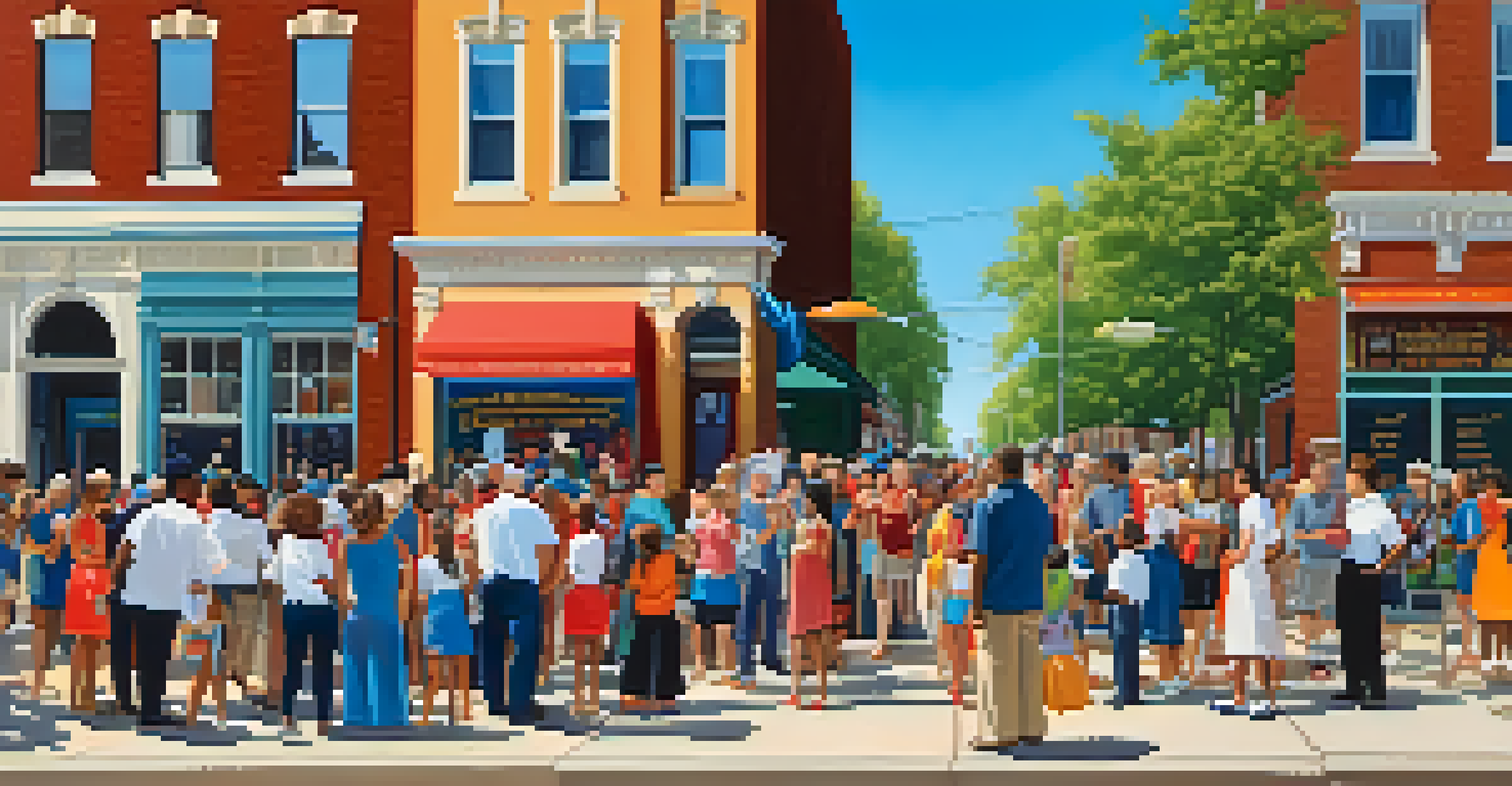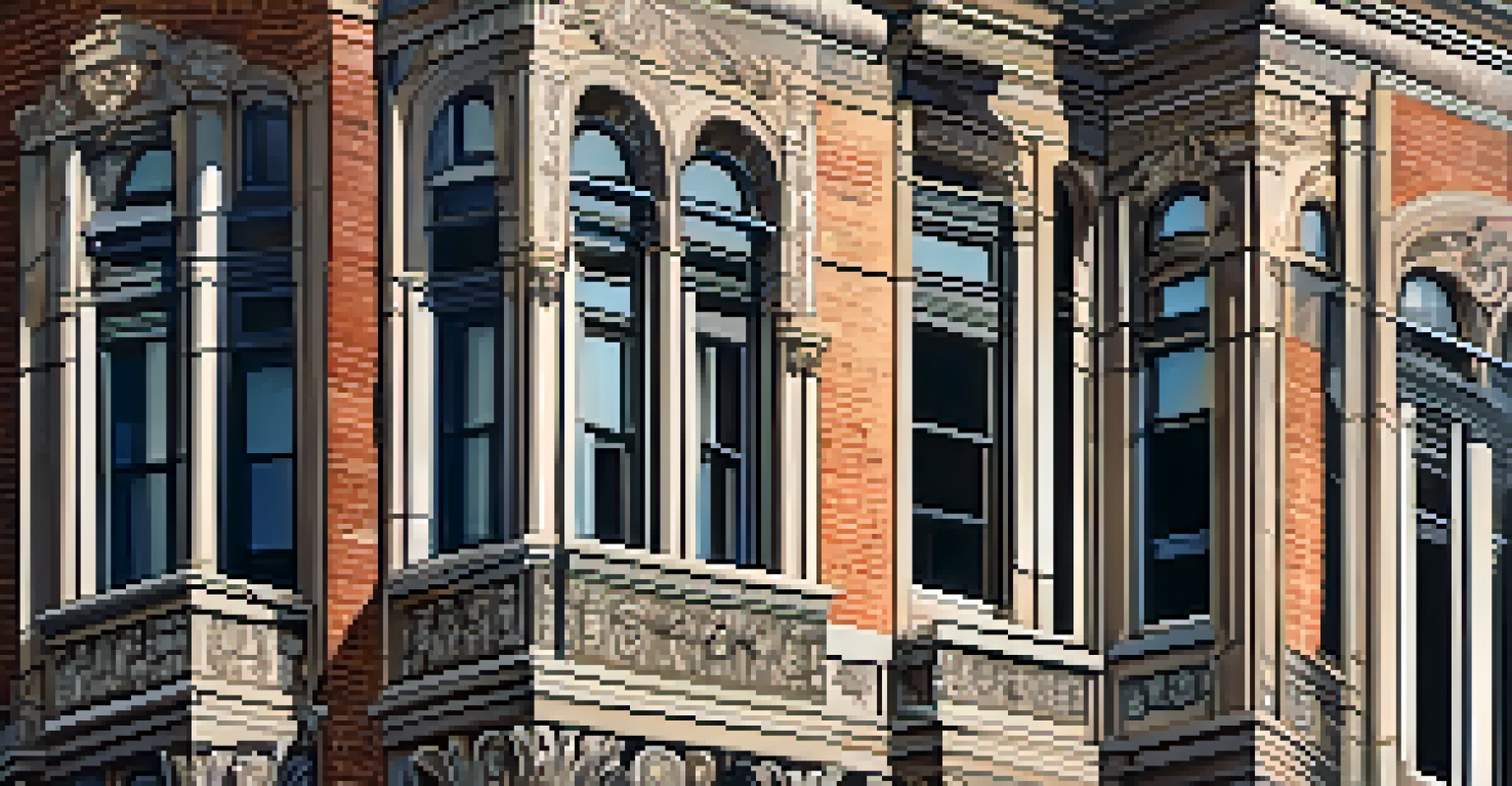Overview of Historic Preservation Efforts in Chicago Today

Chicago's Rich Architectural Heritage and Challenges
Chicago is renowned for its diverse architectural styles, from the iconic skyscrapers to historic brownstones. However, this rich heritage faces significant challenges, including urban development pressures and changing community needs. As the city evolves, the importance of preserving these structures becomes more pronounced, not just for aesthetic reasons, but for cultural identity.
Preservation is not just about saving buildings; it's about saving the stories that define our communities.
Historic buildings serve as physical reminders of the past, telling stories of different eras and the people who lived in them. When these structures are lost, a piece of the city’s narrative disappears. This raises the question: how can we honor the past while accommodating modern growth?
To address these challenges, preservation efforts in Chicago are becoming increasingly organized and strategic, involving local communities, government bodies, and non-profit organizations. Together, they aim to create a balance between development and preservation, ensuring that new projects respect the historic fabric of the city.
Current Preservation Initiatives in Chicago
Today, Chicago boasts a variety of initiatives aimed at preserving its historic sites. The Chicago Landmarks Ordinance, for instance, designates certain buildings and districts as landmarks, providing them with protection against demolition or inappropriate alterations. This legal framework is crucial for safeguarding the city's architectural treasures.

In 2023, several new preservation projects have emerged, focusing on both well-known landmarks and lesser-known sites. These initiatives often include community engagement, where residents can voice their opinions and participate in the preservation process. This not only fosters a sense of ownership but also enriches the preservation efforts with diverse perspectives.
Preservation Balances Growth and History
As Chicago evolves, preservationists strive to balance urban development with the safeguarding of the city's rich architectural heritage.
Moreover, technology plays a significant role in these initiatives. Digital tools such as 3D mapping and online archives are being utilized to document and promote Chicago's historic sites, making them more accessible to the public. This modern approach helps to raise awareness and appreciation for the city’s architectural history.
The Role of Community in Preservation Efforts
Community involvement is at the heart of successful preservation efforts in Chicago. Local residents often spearhead initiatives to protect their neighborhoods, rallying support for various causes such as saving a beloved school or a historic theater. These grassroots movements can be incredibly powerful, leading to significant changes in local policies.
Historic preservation is the best form of sustainability.
Organizations like the Chicago Architectural Foundation provide resources and training for community members interested in preservation. By equipping citizens with knowledge and tools, these organizations empower them to advocate for their historic sites effectively. This collaborative approach ensures that preservation efforts reflect the community's values and needs.
Furthermore, community events such as walking tours, lectures, and workshops help raise awareness about the importance of preservation. These activities not only educate residents about their local history but also foster a sense of pride in their neighborhoods, ultimately reinforcing support for preservation initiatives.
Challenges Faced by Preservationists Today
Despite the enthusiasm for historic preservation, many challenges persist in Chicago. One of the most pressing issues is funding; securing financial support for preservation projects can be difficult, especially when competing with other urgent city needs. This often leaves preservationists scrambling to find resources to maintain and restore historic buildings.
Additionally, the rapid pace of urban development poses a constant threat to historic sites. Developers may prioritize new construction over preservation, leading to tensions between economic growth and cultural heritage. Striking a balance requires ongoing dialogue and negotiation among stakeholders, including city planners, developers, and preservationists.
Community Engagement Drives Initiatives
Local residents play a crucial role in preservation efforts, advocating for their neighborhoods and contributing diverse perspectives to initiatives.
Moreover, gentrification can complicate preservation efforts. As neighborhoods become more desirable, property values rise, making it challenging for long-time residents to stay. This can lead to the loss of not only historic buildings but also the communities they represent, highlighting the need for preservationists to advocate for inclusive practices.
The Impact of Preservation on Local Economy
Preservation is not just about saving buildings; it also has a significant impact on the local economy. Restoring historic structures can create jobs and stimulate economic growth, particularly in tourism and hospitality. Tourists are often drawn to cities with rich histories and well-preserved architecture, contributing to local businesses.
In Chicago, historic preservation efforts can lead to revitalized neighborhoods that attract new residents and businesses. For instance, the redevelopment of historic warehouses into trendy lofts and shops not only preserves the architectural character but also enhances the local economy. This creates a win-win situation for both preservationists and developers.
Additionally, studies have shown that preserved neighborhoods tend to retain their property values better than those without historic character. This stability can be beneficial for homeowners and investors alike, making preservation an attractive proposition for community stakeholders who are focused on long-term growth.
Case Studies: Successful Preservation Projects
Chicago is home to numerous successful preservation projects that serve as inspiring case studies. One notable example is the restoration of the historic Navy Pier, which has transformed into a vibrant public space while retaining its historic charm. The project involved careful planning to integrate modern amenities without compromising the site's historical integrity.
Another success story is the preservation of the Pullman National Monument, which highlights the importance of the Pullman Company in American labor history. This site not only promotes historical awareness but also engages the community through educational programs and events, showcasing the potential of preservation to foster local pride.
Economic Benefits of Historic Preservation
Restoring historic buildings not only enhances cultural identity but also stimulates local economies by attracting tourism and revitalizing neighborhoods.
These examples demonstrate that preservation can breathe new life into historic sites, making them relevant for contemporary audiences. By showcasing successful projects, preservationists can inspire further efforts and encourage collaboration between communities, government, and private organizations.
Future Directions for Chicago's Historic Preservation
Looking ahead, the future of Chicago's historic preservation efforts appears promising but requires ongoing commitment and innovation. As the city continues to grow, preservationists are exploring new strategies to adapt to changing landscapes while maintaining historical integrity. This includes advocating for more inclusive preservation practices that reflect the diverse communities within Chicago.
Emerging technologies, such as virtual reality and augmented reality, are being integrated into preservation efforts, offering new ways for people to engage with history. These technologies can help visualize the past, making it easier for residents and visitors to appreciate the significance of historic sites. Such innovative approaches can enhance community involvement and attract a younger audience.

Ultimately, the future of historic preservation in Chicago will depend on collaboration among all stakeholders. By fostering partnerships between government, businesses, and residents, the city can create a robust preservation framework that not only protects its past but also enriches its future.